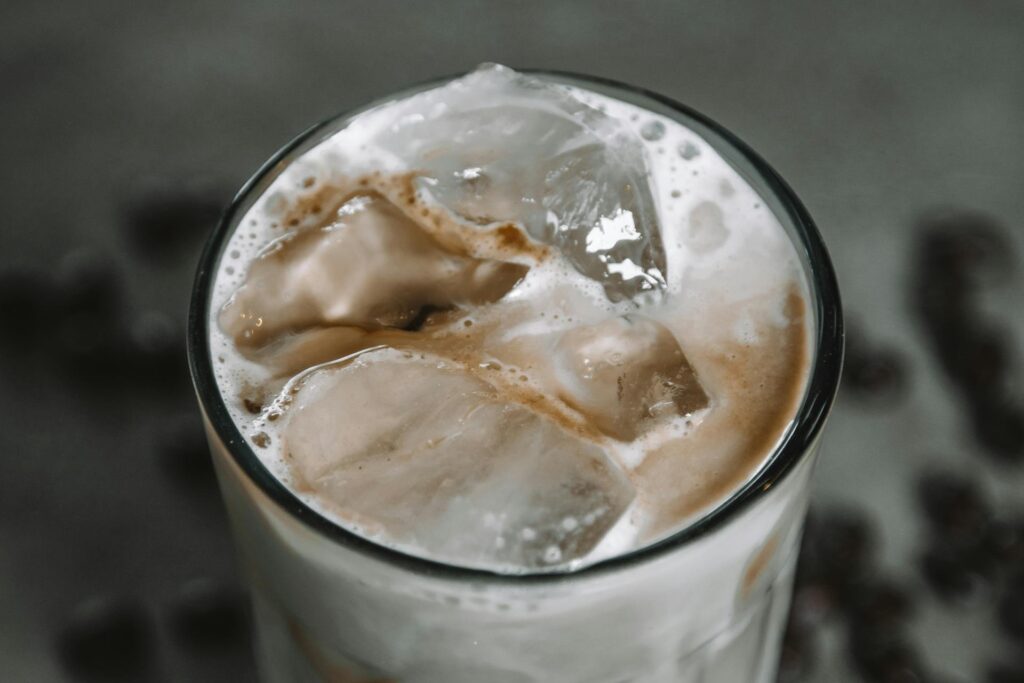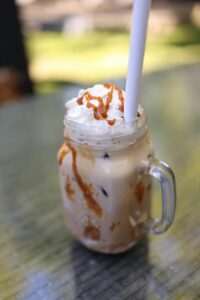Nothing kills the joy of iced coffee faster than that first sip of weak, watery brew.
You know the one—when the ice melts faster than you can drink it, leaving you with a sad cup of coffee-flavored water.
The culprit is simple: hot coffee plus plain ice equals instant dilution.
But the good news? You don’t have to put up with it.
With the right brewing methods and a few clever tricks, your iced coffee can stay bold, smooth, and refreshing to the very last sip!
The Problem with Watery Iced Coffee
When you pour hot coffee straight over a handful of regular ice cubes, you’re basically setting up a race you can’t win because the ice melts at lightning speed, flooding your cup with water before the coffee even cools down.
That quick melt means the rich flavor you brewed so carefully gets thinned out in seconds, leaving you with something that tastes more like coffee’s distant cousin than the real deal.
It’s the same frustration as adding too much water to soup: all the depth and character vanish, and you’re left sipping on disappointment.
The truth is simple—heat plus ice equals instant dilution, and unless you change how you brew or how you chill, your iced coffee will always struggle to hold on to its strength.
Brew Methods That Prevent Wateriness
A. Cold Brew Method
Cold brew is the king of smooth, bold iced coffee because it’s made as a concentrate.
Instead of brewing hot and shocking it with ice, you let coarsely ground coffee steep in cold water for 12–24 hours.
The result is a strong, naturally concentrated base that doesn’t blink at a few melting cubes.
A good starting ratio is one part coffee to four or five parts water (1:4 or 1:5), which gives you a concentrate you can later dilute with milk or more water to taste.
Another bonus? Cold brew is lower in acidity, which makes it gentler on the stomach and perfect for those who like their iced coffee smooth and mellow instead of sharp and bitter.
B. Japanese Iced Coffee (Flash Brew)
If you love the bright, lively flavors of hot-brewed coffee but hate the watery aftermath, Japanese iced coffee—also called flash brew—is your golden ticket.
The trick is brewing hot coffee directly over ice, using a pour-over method like a Chemex or V60. The heat extracts all the delicate flavors, while the immediate cooling locks them in.
To keep the strength balanced, you slightly reduce the amount of hot water used and let the ice provide the rest of the liquid.
This way, the final cup is flavorful, aromatic, and cold from the start—without tasting like watered-down leftovers.
C. Espresso-Based Iced Coffee
Sometimes, less is more, and espresso proves that point beautifully. A concentrated shot or two of espresso poured over ice delivers a bold punch that can stand its ground as the cubes melt.
On its own, it’s intense and refreshing; with milk or cream, it transforms into a café-style iced latte that feels indulgent but still keeps its flavor.
Because espresso is brewed strong and fast, you don’t need much to create an iced coffee that won’t collapse under the weight of a little water.
This method is quick, reliable, and perfect if you’ve got an espresso machine or even a moka pot handy.
Ice Hacks to Avoid Dilution
A. Coffee Ice Cubes
One of the simplest tricks in the book is turning your leftover coffee into ice cubes.
Instead of pouring the dregs of the pot down the sink, freeze them in an ice tray and stash them for your next iced coffee fix.
When those cubes melt, they don’t water things down, but they instead deepen the flavor. It’s like giving your drink a little refill as you sip.
Plus, you can get creative: try freezing strong brews, flavored coffees, or even cold brew concentrate for extra oomph.
The best part? It costs nothing and solves the watery-iced-coffee problem instantly.
B. Milk or Cream Ice Cubes
If you’re more of a latte or mocha person, milk or cream ice cubes are a game-changer. Pour regular milk, plant-based alternatives, or even flavored creamers into an ice tray and freeze them solid.
Drop a few into your glass, and instead of diluting your coffee, they slowly melt into creamy goodness. It’s like your iced coffee is dressing itself up as you drink it.
Bonus points if you use chocolate milk or vanilla creamer—suddenly, every sip feels like a little café treat without paying café prices.
Strengthening Your Base Brew
One of the easiest ways to outsmart watery iced coffee is to simply start stronger, meaning brew your coffee about 25–50% more concentrated than usual, so it has the muscle to stand up to melting ice.
You can do this by tweaking your grind size a bit finer or letting the coffee steep or brew a little longer, both of which pull out more flavor and body from the beans.
Sure, you might notice a touch more bitterness when sipping it hot, but once it hits the ice, that edge evens out beautifully, leaving you with a balanced, bold cup that doesn’t collapse into blandness halfway through.
Think of it like seasoning food: a pinch more salt before cooking makes sure the finished dish tastes just right—same idea with coffee strength.
Flavor Boosters That Distract From Dilution
Even if a little water sneaks into your iced coffee, you can outsmart it with flavor boosters that keep your taste buds busy.
A splash of syrup, like vanilla, caramel, or even a quick homemade simple syrup, adds sweetness that lingers no matter what the ice does.
Spices are another secret weapon: a dash of cinnamon, nutmeg, or cardamom can turn an ordinary glass into something that feels like it came from a café menu.
And let’s not forget creamers and plant-based milks; whether it’s almond, oat, or a flavored creamer like hazelnut, these extras layer richness and personality onto your coffee so it tastes indulgent from the first sip to the last drop.
In other words, if dilution is inevitable, you can still make sure the flavor profile stays exciting enough that you don’t miss a beat.
Practical Tips & Tricks
Sometimes it’s the little moves that make the biggest difference, and iced coffee is no exception.
Instead of pouring piping-hot coffee straight over ice, give it a quick chill in the fridge first—this way, the ice doesn’t have to do all the heavy lifting and your drink keeps its punch.
When it comes to the cubes themselves, size matters: larger cubes melt more slowly, so your coffee stays bold instead of turning into a sad puddle of brown water.
And here’s a pro move most people skip—pre-chill your glass or shaker. Just a few minutes in the freezer, and suddenly your drink holds its cool a lot longer.
It’s the same reason cold beer in a frosty mug tastes better; temperature control keeps everything crisp, refreshing, and exactly how you want it.
Common Mistakes to Avoid
Brewing Weak Coffee and Expecting Ice Not to Ruin It
If your starting point is a weak brew, no amount of tricks will save it once the ice gets involved. Think of it like trying to stretch a thin soup—you’ll only end up with flavored water.
Always brew stronger than you normally would so the flavor has enough backbone to hold up against melting cubes.
Using Lukewarm Coffee + Ice
Pouring lukewarm coffee over ice is like asking for disaster on purpose. The ice melts instantly, dilutes everything, and you’re left with a sad, flat drink before you even take your first sip.
Either chill your coffee in the fridge first or brew directly over ice using the right method, so the temperature shift works in your favor instead of against you.
Adding Sweeteners After Icing
Dropping sugar into an already iced coffee is a recipe for disappointment—literally.
Granules don’t dissolve well in cold liquid, so you’ll often find yourself sipping uneven sweetness or crunching stray crystals at the bottom.
The smarter move is to mix in sweeteners while the coffee is still warm or use liquid options like simple syrup that blend smoothly even when cold.
Final Words
A watery iced coffee doesn’t have to be your fate. With smarter brewing methods and a few clever ice tricks, you can keep every sip bold and refreshing.
Experiment with cold brew, flash brew, or espresso until you find the style that matches your taste. Don’t be afraid to play around because half the fun is in the testing.
Here’s your challenge: freeze a tray of coffee ice cubes tonight.
Tomorrow, drop them in your glass and see how much better iced coffee can be when dilution isn’t part of the deal!
FAQs
Can I make iced coffee with instant coffee without it getting watery?
Yes, you just need to make it stronger than usual. Mix more granules with less water, chill it first, then pour over ice. Quick, simple, and surprisingly effective.
How long does cold brew concentrate last in the fridge?
Cold brew concentrate keeps well for about 7–10 days if stored in a sealed container. After that, the flavor starts to fade.
Is cold brew stronger than iced coffee?
Usually, yes. Cold brew is made as a concentrate, so it naturally packs more caffeine and flavor. Iced coffee, unless brewed stronger, is just chilled regular coffee.
Can I use flavored syrups instead of sugar?
Absolutely. Syrups dissolve instantly in cold drinks, making them a perfect swap. Plus, you get fun flavors like vanilla, caramel, or hazelnut that sugar alone can’t offer.



